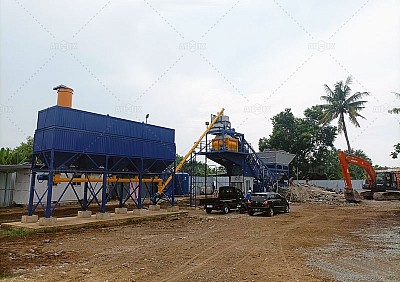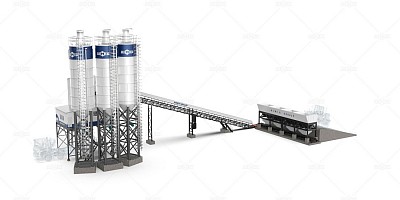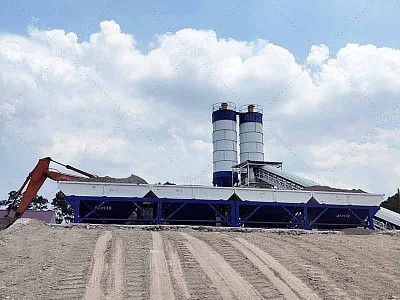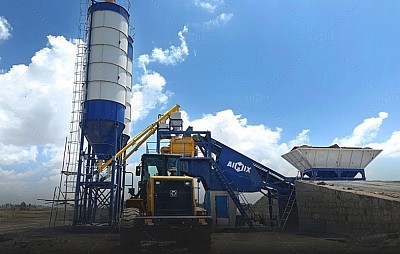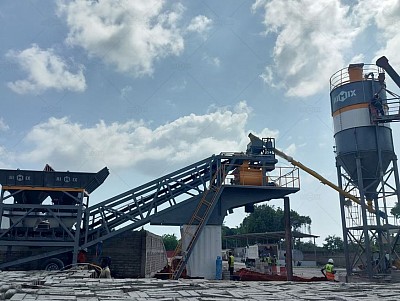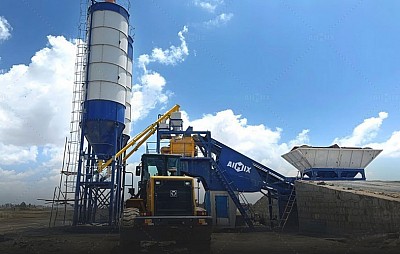Technology News and Industry Trends about Concrete Plants
Job-Site-to-Job-Site: Why Portability of Mobile Concrete Plant Equals Higher Efficiency
The construction industry's relentless pursuit of efficiency has found its latest champion in mobile concrete plants, whose inherent portability solves one of the sector's most persistent challenges: the high cost of static production facilities. Unlike traditional batching plants that anchor operations to a single location, mobile units transform concrete production into a dynamic, just-in-time process that follows the workflow. This paradigm shift eliminates the logistical inefficiencies of long material hauls while enabling precise placement coordination that cuts waste by up to 30%. The true value proposition lies not just in mobility itself, but in how it reconfigures the entire concrete supply chain around project needs rather than production constraints.
Reduced Dead Time, Increased Utilization
Mobile concrete plants achieve what stationary installations cannot—near-continuous operation across multiple projects. Where fixed plants typically operate at 60-70% capacity due to geographic limitations, mobile units maintain 85-90% utilization through sequential deployment. This leap in asset productivity stems from two key advantages: rapid demobilization (often under 8 hours for full plant relocation) and instant readiness upon arrival.
The economic impact is profound. A mid-sized contractor running three concurrent projects can service all sites with one mobile concrete batching plant for sale instead of purchasing or leasing multiple stationary units. This single-asset strategy reduces capital expenditures by 40-60% while eliminating the idle time that plagues traditional setups when projects stall or weather interferes. The plants' compact footprints (typically under 2,000 sq ft) further enhance efficiency by minimizing the need for extensive site preparation at each new location.
Precision Logistics for Modern Construction
Today's complex projects demand concrete delivery synchronization that most stationary plants cannot provide. Mobile units excel at phased placement strategies, positioning themselves optimally for each construction stage. For high-rise cores, they nestle against the building perimeter; for bridge decks, they relocate to follow the advancing span. This proximity reduces transit mixer cycle times by up to 75% compared to distant fixed plants.
Advanced models now incorporate telematics-driven logistics. GPS tracking of mixer fleets allows plants to adjust production rates in real-time, maintaining perfect pour continuity without overproduction. Some systems even predict traffic patterns, automatically rescheduling batches to avoid congestion delays. This logistical intelligence transforms portable concrete batch plants from simple production units into nerve centers for concrete placement strategy.
The Sustainability Dividend of Localized Production
Portability delivers unexpected environmental benefits that align with green construction mandates. By eliminating long-haul material transport, mobile plants cut diesel consumption by 300-500 gallons per day on typical projects. Their ability to source local aggregates (often within 10 miles instead of 50+ miles for stationary plants) further reduces the carbon footprint of concrete production.
Modern designs enhance these advantages with closed-loop water systems that recycle 95% of process water and dust suppression technology that maintains air quality standards even in urban settings. The plants' electric-hybrid power options allow quiet overnight operation near residential areas—a capability that has made them indispensable for infrastructure repairs in noise-sensitive locations.
The efficiency equation for mobile concrete plants extends beyond mere transportation savings. It encompasses labor optimization, material conservation, and schedule compression that together redefine what's possible in concrete construction. As projects grow more complex and margins tighten, the ability to bring production exactly where and when it's needed represents not just an operational improvement, but a fundamental competitive advantage. The future belongs to contractors who recognize that in concrete production, movement equals efficiency, and efficiency equals profit.
Smarter Control, Better Concrete: Why PLC-Driven Ready Mix Concrete Plants Are Industry Standard
The ready-mix concrete industry has undergone a quiet revolution, with programmable logic controller (PLC) systems emerging as the undisputed brains behind modern batching operations. These sophisticated control platforms have evolved beyond simple automation to become comprehensive concrete management systems that optimize every production variable—from aggregate moisture compensation to mixer blade wear patterns. Their dominance stems not from technological novelty alone, but from delivering measurable improvements in consistency, efficiency, and compliance that mechanical systems simply cannot match.
Precision Batching Beyond Human Capability
PLC systems achieve weighing accuracies of ±0.1% for cementitious materials and ±0.5% for aggregates—tolerances impossible to maintain with manual operations. This precision stems from three key innovations:
High-speed load cell sampling that detects minute weight variations during feeding
Predictive cut-off algorithms that anticipate material flow to prevent overbatching
Automatic moisture compensation adjusting water content in real-time based on microwave sensors
The results are tangible. Ready mix plant utilizing advanced PLC controls report 98% compliance with specified mix designs, compared to 82% at manually controlled facilities. This consistency proves particularly valuable for high-performance concrete applications where a 0.02 change in water-cement ratio can impact 28-day strength by 5 MPa.
Adaptive Mixing Intelligence
Modern PLCs don't just follow recipes—they optimize them. By analyzing power draw curves during mixing, these systems automatically adjust:
Mixing time based on detected homogeneity (typically ±15 seconds variance)
Sequence optimization for fiber-reinforced or viscous mixes
Admixture injection timing to coincide with optimal rheology windows
This dynamic approach reduces energy consumption by 18-22% compared to fixed-time mixing cycles while improving early-age strength consistency by 30%. The systems also track mixer blade wear patterns, automatically compensating for reduced efficiency by slightly extending mixing durations—a feature that extends blade life by 200-300 hours.
Compliance and Connectivity Advantages
PLC-driven plants maintain immutable digital records of every batch—a requirement for modern construction standards. These systems automatically:
Log material certificates and expiration dates
Flag non-compliant deviations before discharge
Generate audit trails for EN 206, ASTM C94, and other certifications
Cloud-connected PLC platforms enable real-time quality monitoring across multiple concrete batching plant for sale, allowing centralized technical teams to adjust mixes remotely based on performance data. This capability has proven invaluable for large infrastructure projects where identical concrete specs must be maintained across geographically dispersed batching locations.
The PLC's dominance reflects a fundamental truth: consistent, high-quality concrete production requires more precision than human operators can sustainably deliver. These systems have raised the industry standard to a level where 1% variance in mix parameters is considered unacceptable—a stark contrast to the 5-8% tolerances common in pre-automation eras. As concrete technology advances toward smarter admixtures and more sustainable formulations, PLC controls will remain the essential platform ensuring these innovations perform as intended, batch after batch. Their value proposition extends beyond automation—they are the guardians of concrete quality in an era where "close enough" is no longer good enough.
Global Leaders: A Look at the Top Concrete Batching Plant Manufacturers Worldwide
The concrete batching plant industry thrives on innovation, durability, and precision—qualities embodied by a select group of concrete batching plant manufacturers who have risen to global prominence. These industry leaders don’t just build equipment; they shape construction methodologies, influence project timelines, and redefine efficiency standards. Among them, AIMIX Group stands out as a paragon of technological advancement, but it operates alongside other formidable players, each contributing unique strengths to the sector.
AIMIX Group: Pioneering Innovation in Concrete Batching Technology
AIMIX Group has carved a niche as a manufacturer synonymous with adaptability and performance. Their batching plants, ranging from compact mobile units to sprawling stationary installations, are engineered for seamless operation in diverse climates—from the freezing tundras of Scandinavia to the scorching deserts of the Middle East. What sets AIMIX apart is their emphasis on modularity; clients can customize plants with optional add-ons like advanced dust collectors, moisture probes, or hybrid power systems.
The company’s R&D investments yield tangible benefits, such as the proprietary twin-shaft mixer design that achieves homogenization in record time. AIMIX concrete batching plants for sale also integrate IoT-enabled monitoring, allowing operators to track production metrics, maintenance schedules, and even diagnose faults remotely. Such features explain their dominance in emerging markets, where infrastructure projects demand both sophistication and ruggedness.
Industry Titans: Other Leading Manufacturers Shaping the Market
Europe’s engineering prowess is exemplified by manufacturers like Liebherr and BHS-Sonthofen. Liebherr’s batching plants are masterclasses in precision, with load cells capable of measuring aggregates to within 0.1% accuracy. Their energy-recovery systems, which repurpose brake energy from conveyor belts, reflect a commitment to sustainability rare in heavy machinery. BHS-Sonthofen, meanwhile, specializes in high-output planetary mixers that minimize wear while maximizing mix quality—a favorite for high-spec projects like airport runways.
Across the Atlantic, CON-E-CO and RexCon represent North America’s industrial ethos: durability meets simplicity. Their plants feature heavy-duty steel frames and open layouts designed for easy maintenance—critical for remote sites where technician visits are infrequent. RexCon’s legendary “Auto-Ram” concrete batcher, with its zero-slump consistency, has become an industry benchmark for precast concrete production.
Emerging Trends and Future Directions in Batching Plant Manufacturing
Sustainability is no longer optional; it’s a competitive edge. Leading manufacturers now incorporate solar-powered control cabins, recycled water systems, and carbon footprint trackers directly into plant designs. The shift toward electrification is equally pronounced, with several companies piloting fully electric mixers that eliminate diesel exhaust—and noise—from urban job sites.
Modularity is another frontier. Projects increasingly favor “plug-and-play” ready mix plant that can be disassembled and redeployed across multiple sites. AIMIX’s quick-release conveyor couplings and containerized control rooms exemplify this trend, reducing setup time from weeks to days. Meanwhile, AI-driven predictive maintenance algorithms are becoming standard, analyzing vibration patterns and lubrication data to forecast component failures before they occur.
The Human Factor: Engineering for Real-World Challenges
Behind every global leader’s success lies an acute understanding of on-the-ground realities. AIMIX’s plants, for instance, include multi-language interfaces to accommodate multinational crews, while Liebherr offers virtual reality training simulators to reduce operator learning curves. These nuances matter—a plant that’s intuitive to operate in Mumbai must perform just as reliably under the supervision of a German engineer in Berlin.
The convergence of local adaptability and global standards defines the industry’s future. As urbanization accelerates and infrastructure demands grow more complex, these manufacturers aren’t just selling machinery; they’re delivering the backbone of modern civilization—one perfectly mixed cubic meter at a time.
How Mobile Concrete Batching Plants Optimize Small Infrastructure Projects in Tanzania
Tanzania's growing infrastructure development presents unique challenges, particularly for small-scale projects scattered across diverse geographic regions. Traditional concrete supply methods often prove impractical for rural road networks, localized water projects, and community-based construction initiatives. Mobile concrete batching plants have emerged as a transformative solution, offering unparalleled flexibility and efficiency for these smaller-scale yet critical developments. Their ability to deliver quality concrete exactly where and when needed is revolutionizing how Tanzania approaches its infrastructure growth.
Overcoming Geographic and Logistical Barriers
Tanzania's varied terrain—from coastal plains to mountainous highlands—creates significant transportation challenges for ready-mix concrete. Mobile batching plants eliminate the need for long-haul concrete delivery, which often results in material degradation and inconsistent quality. These self-contained units can be positioned directly at project sites, even in remote locations with limited access.
The compact footprint of mobile plants allows installation in constrained urban areas where traditional batching facilities would be impractical. For Tanzania's growing secondary cities like Mbeya and Mwanza, this means infrastructure projects can proceed without being constrained by central mixing plant locations. The mobility factor proves particularly valuable when working on linear projects like rural road sections, where the ready mix concrete plant can relocate along the construction path as work progresses.
Cost-Effective Operations for Limited Budgets
Small infrastructure projects in Tanzania often operate with constrained budgets that cannot accommodate the overhead of large-scale concrete production. Mobile batching plants provide an economical alternative by reducing multiple cost factors simultaneously. Transportation expenses disappear when production occurs on-site, and the reduced need for stabilizers and admixtures to maintain concrete quality during transit creates additional savings.
Labor costs also decrease significantly. These automated systems require smaller crews than traditional methods, while still providing employment opportunities for local workers. The precise measuring systems minimize material waste—a critical factor when working with limited budgets. Perhaps most importantly, the ability to produce concrete in smaller batches matches the pace and scale of Tanzania's community-focused projects, preventing the material loss associated with large, infrequent pours.
Adapting to Tanzania's Unique Project Requirements
Tanzania's infrastructure development often involves customized solutions tailored to specific community needs and local materials. Portable concrete plants for sale excel in this environment through their remarkable adaptability. Operators can easily adjust mix designs to incorporate locally available aggregates, optimizing costs while supporting regional economies. This flexibility proves invaluable when working in areas with limited access to standard construction materials.
The plants also accommodate Tanzania's variable power infrastructure. Many models can operate on generator power where grid electricity is unreliable, ensuring consistent production regardless of location. Some advanced units even incorporate solar-hybrid systems, reducing fuel dependency—an important consideration for projects in environmentally sensitive areas or those following green building principles.
As Tanzania continues to develop its infrastructure network, mobile batching plants are proving to be more than just equipment—they're strategic tools enabling localized, efficient, and sustainable construction. Their ability to deliver quality concrete while overcoming Tanzania's unique geographic, economic, and logistical challenges makes them indispensable partners in the nation's development journey. For district engineers, local contractors, and community development organizations, these mobile solutions represent the perfect marriage of appropriate technology and practical innovation.
Top Regions Choosing Dry Mix Concrete Plants for Cost-Effective Production
The global construction industry continues its inexorable march toward operational efficiency, and nowhere is this more evident than in the strategic adoption of dry mix concrete plants. Unlike traditional wet batch plants that premix all components before transportation, dry mix facilities only blend raw materials at the point of application, offering profound logistical and economic advantages. This paradigm shift represents more than mere technical preference—it reflects regional responses to unique infrastructural demands, environmental constraints, and economic imperatives.
Certain geographical areas have emerged as particularly enthusiastic adopters of this technology, leveraging its benefits to overcome local challenges. From water-scarce deserts to rapidly urbanizing megacities, dry mix plants provide solutions where conventional concrete production would prove prohibitively expensive or logistically untenable. The convergence of economic pragmatism and engineering innovation has created distinct hotspots of adoption across the globe.
Arid and Water-Scarce Regions: The Middle Eastern
AdvantageGulf Cooperation Council (GCC) Dominance
The Arabian Peninsula's extreme aridity makes water conservation a paramount concern, positioning dry mix technology as the obvious choice. Saudi Arabia's NEOM project and Qatar's Lusail City development rely extensively on dry mix plants that reduce water consumption by 90% compared to wet batch alternatives. The region's massive infrastructure investments—exceeding $1 trillion in planned projects—prioritize technologies that minimize environmental impact while maintaining relentless construction schedules.
North African Adoption Patterns
Morocco and Egypt lead African adoption, leveraging dry mix plants for large-scale housing projects and desert infrastructure. The technology's minimal water requirements prove invaluable in regions where potable water remains scarce and construction must continue unabated. Egyptian New Alamein City's 50,000-unit housing project utilizes mobile dry mix plants that follow construction progress, eliminating the need for central mixing facilities and reducing transportation costs by 40%.
Rapidly Urbanizing Asian Megacities
Indian Metropolitan Innovation
Mumbai and Delhi's explosive growth has overwhelmed traditional concrete supply chains, creating ideal conditions for dry mix adoption. The technology's compact footprint allows concrete plants for sale to operate within city limits, reducing transit times and congestion in already overcrowded streets. Indian developers report 25% cost reductions on high-rise projects through just-in-time production that eliminates waste and reduces inventory costs.
Southeast Asian Coastal Developments
Vietnam and Indonesia's archipelago geographies make centralized concrete production impractical. Dry mix plants mounted on barges now service coastal megaprojects, producing concrete on-site without the degradation issues that plague wet mix during prolonged marine transport. This approach has revolutionized construction in Indonesia's new capital Nusantara, where challenging logistics previously threatened to delay development timelines.
Remote Mining and Infrastructure Projects
Australian Outback Applications
Australia's mining industry operates in extreme isolation, where traditional concrete supply chains would be economically unsustainable. Dry mix plants at sites like the Pilbara iron ore region produce concrete using local aggregates and imported cement, slashing transportation costs by 60% while ensuring consistent quality in challenging environments. The technology's mobility allows plants to relocate as mining faces shift, maintaining optimal efficiency throughout project lifecycles.
Canadian Northern Development
Arctic infrastructure projects face brief construction windows and extraordinary logistical challenges. Dry mix plants operating in Nunavut and Yukon territories produce concrete during the limited summer months, storing dry materials through winter for gradual use. This approach has proven essential for maintaining Canada's northern infrastructure despite temperatures that would freeze traditional wet mix during transportation.
European Focus on Sustainability and Regulation
Scandinavian Environmental Leadership
Sweden and Norway's stringent carbon emissions regulations have accelerated dry mix adoption. The technology's reduced energy consumption and ability to incorporate industrial byproducts (like fly ash and slag) align perfectly with circular economy objectives. Norwegian tunnel projects achieve 30% lower carbon footprints through dry mix systems that optimize cement usage and minimize waste.
Alpine Construction Adaptations
Mountainous regions in Switzerland and Austria benefit from dry mix plants' ability to operate in limited spaces and variable temperatures. The technology's resistance to freezing during transportation makes it indispensable for high-altitude infrastructure maintenance and ski resort development, where conventional concrete would freeze in transit during winter months.
The Economic Calculus Driving Adoption
The proliferation of dry mix plants follows a clear economic logic: regions facing either extreme environmental conditions or accelerated development timelines find the technology's advantages irresistible. The 15-30% overall cost reduction, combined with dramatically reduced water usage and environmental impact, creates a compelling value proposition that transcends mere technical preference. As construction globalizes further and sustainability regulations tighten, dry mix technology will likely become the default choice rather than the exception for progressive regions worldwide.
How to Calculate the Total Cost of Ownership for a Mobile Concrete Batching Plant
The decision to acquire a mobile concrete batching plant is a significant commitment, one that promises enhanced operational flexibility and on-site production control. However, focusing solely on the initial sticker concrete plant price is a myopic approach that can lead to unforeseen financial strain. The true financial footprint of this vital asset is its Total Cost of Ownership (TCO), a comprehensive metric that paints a complete picture of its economic impact over its entire service life. This calculation requires a meticulous and forward-looking analysis, encompassing not just the capital expenditure but the relentless cascade of operational, maintenance, and ancillary costs that accrue over time. Understanding TCO is not merely an accounting exercise; it is a strategic imperative that empowers business owners to make informed, sustainable investments, ensuring that the machinery that serves as the backbone of their operation is also a sound pillar of their financial health.
Moving Beyond the Purchase Price: A Holistic Financial Framework
The journey to an accurate TCO begins by acknowledging that the purchase mobile batching plant price is merely the first chapter in a long financial story. This initial capital outlay includes the base cost of the plant itself, but it must also account for a suite of associated expenses that are fundamental to its commissioning. These encompass delivery and transportation to the site, the often-overlooked costs of assembly and installation by specialized technicians, and any necessary civil works to prepare the ground for its operation. Furthermore, initial licensing, registration, and comprehensive insurance premiums form a critical part of this foundational investment. A prudent buyer will also factor in the cost of an initial stock of essential spare parts and wear items, creating a buffer that safeguards against early operational disruptions. This holistic view of the initial financial commitment provides a realistic starting point from which the ongoing costs can be accurately projected.
Once the plant is operational, a new category of expenses emerges, forming the lifeline of daily production. These running costs are the relentless, recurring charges that directly correlate with the volume of concrete produced. The most prominent among these is the raw material cost for each cubic meter of concrete—cement, aggregates, water, and admixtures. Alongside this, energy consumption, whether from diesel generators or grid electricity, represents a significant and variable expense. Regular, preventative maintenance, while a cost in itself, is an investment that mitigates far larger repair bills down the line. Indirect costs, such as ongoing insurance, periodic regulatory compliance checks, and the allocation of funds for future major overhauls, must also be diligently accounted for in this comprehensive financial framework.
Quantifying the Operational Expenditure: The True Cost of Production
Delving deeper into the operational phase reveals the granular details that truly define the plant's efficiency and cost-effectiveness. The plant's appetite for fuel or electricity is a constant financial meter, ticking with every hour of operation. A modern, energy-optimized plant with efficient motors and well-sealed hydraulic systems will consume significantly less power over its lifetime compared to a less sophisticated model, leading to substantial cumulative savings. This makes the plant's specified fuel consumption rate a critical data point in any TCO calculation, as even a minor difference in efficiency can translate into a major financial divergence over years of service.
Simultaneously, the cost of wear parts and consumables constitutes an inescapable reality of operation. Components like mixer blades, liners, conveyor belts, and filter elements are subject to constant attrition. The quality of these parts, their expected service life, and the ease and cost of their replacement are pivotal factors. A plant designed for easy maintenance and stocked with durable, readily available wear parts will incur lower downtime and consumable costs. Furthermore, the human resource required to operate the plant—skilled operators, maintenance technicians, and quality control supervisors—represents a recurring labor cost that is directly tied to the plant's operational hours and complexity. An intuitive control system and a robust design can enhance labor efficiency, reducing the time and expertise required for routine tasks and troubleshooting.
The Intangible Factors: Value, Support, and Financial Agility
Finally, a truly enlightened TCO analysis must incorporate factors that, while not always appearing on an invoice, have a profound impact on long-term value and financial stability. The reputation of the concrete batching plant manufacturer and the robustness of their after-sales support network are invaluable assets. A supplier that provides comprehensive training, readily available technical assistance, and a reliable pipeline of genuine spare parts directly contributes to higher operational uptime and lower lifetime repair costs. This support ecosystem is a form of financial risk mitigation.
The plant's reliability directly influences opportunity cost. A machine that is frequently offline disrupts project timelines, damages client relationships, and forfeits potential revenue. Therefore, the plant's proven mean time between failures is not just an engineering metric; it is a financial one. Lastly, the structure of the acquisition itself—whether through cash purchase, financing, or leasing—affects cash flow and tax liabilities. A favorable financing plan can make a higher-quality, more reliable plant accessible, improving its net present value and making it the most financially astute choice in the long run. The cheapest plant on paper can become a financial burden, while a slightly more expensive, but more reliable and efficient machine, often proves to be the most economical partner for years to come.
Eco-Revamp Your Portable Concrete Plant: Innovative Retrofits to Minimize Emissio
The concrete production industry stands at an environmental crossroads, where portable plants face increasing pressure to reduce their carbon footprint without sacrificing operational flexibility. Retrofitting existing mobile batching equipment with emissions-reduction technologies offers a pragmatic solution—blending the mobility contractors require with the sustainability regulators demand. These smart upgrades target three critical pollution sources: particulate matter from material handling, NOx/SOx emissions from power generation, and wastewater discharge from cleaning cycles.
Modern retrofit packages transform aging portable concrete batch plant into environmentally conscious operations, often achieving 50-70% reductions in key emissions metrics. The business case has never been stronger—with payback periods under 24 months through fuel savings, reduced waste, and avoided regulatory penalties. These upgrades prove that environmental responsibility and mobile concrete production aren’t mutually exclusive, but rather complementary aspects of next-generation construction.
Intelligent Dust Suppression Systems
Electrostatic Precipitation Technology
Traditional baghouses give way to hybrid electrostatic precipitators that capture sub-micron particles missed by conventional filters. These systems apply 20,000-40,000 volts to charge dust particles, achieving 99.9% collection efficiency while using 30% less energy than pulse-jet alternatives. Retrofits typically install within existing ready mix concrete plant footprints, maintaining portability while eliminating visible emissions.
Smart Material Moisture Control
Microwave moisture sensors paired with automated spray systems maintain optimal aggregate dampness—enough to suppress dust but not so much as to compromise mix quality. The system self-adjusts based on real-time material analysis, reducing water usage by 25% compared to manual methods while cutting particulate emissions by 85%.
Clean Power Conversion Packages
Diesel-Electric Hybrid Drives
Retrofit kits replace conventional diesel-hydraulic systems with generator-electric motor configurations. During peak demand, the diesel generator runs at optimal RPM for clean combustion; during low-load periods, battery banks take over. This cuts fuel consumption by 35% and reduces NOx emissions to Tier 4 Final levels without aftertreatment.
Renewable Energy Integration
Fold-out solar arrays and vertical-axis wind turbines mount directly to mobile concrete batching plant structures, providing 15-25% of energy needs. Smart controllers prioritize renewable sources, automatically engaging generators only when necessary. Some systems now incorporate kinetic energy recovery from conveyor braking systems.
Closed-Loop Water Reclamation
Three-Stage Filtration Systems
Compact retrofit modules treat washwater through sedimentation, dissolved air flotation, and reverse osmosis. The system recovers 95% of process water while concentrating waste into a filter cake suitable for incorporation into low-grade concrete products. This eliminates discharge permits and reduces freshwater costs by $15,000-$25,000 annually.
Balancing Automation
Chemical injection systems maintain ideal water chemistry for reuse, preventing the alkalinity buildup that traditionally limited closed-loop systems. ORP (oxidation-reduction potential) sensors trigger precise doses of treatment chemicals, extending water reuse cycles indefinitely.
The era of portable plants as environmental liabilities is ending. These retrofit solutions demonstrate that mobility and sustainability can coexist—provided operators embrace smart technologies that optimize rather than compromise their equipment’s fundamental value proposition. With carbon pricing mechanisms looming and green construction mandates expanding, these upgrades represent both an environmental imperative and a strategic advantage in an increasingly eco-conscious market.
